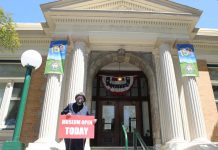In 1833, John Gilroy described himself as a soap maker and millwright. In 1842, there were several references to the flourmill of William Mathews “at Gilroy’s.” By 1845, the era of Spanish and Mexican colonization was coming to an end in the region. The missions had been secularized and all the desirable lands had been granted to the local citizenry. John Gilroy and John Martin acquired 4,461 acres in 1867 from San Ysidro Rancho owner Ygnacio Ortega.
The dominant industry was cattle ranching with the export of hides and tallow the primary source of income. With the exception of soap and wheat, manufactured articles and finer foodstuffs were imported.
During the Mexican era, the El Camino Real passed through the small settlement at San Ysidro. The settlement grew out of the activities associated with the commerce that was conducted at the Ortega/Gilroy rancho compound.
In 1852, John Gilroy began selling small town lots on both sides of Pacheco Pass Road. The area was also called “Gilroy’s,” meaning Gilroy’s rancho. Later, the settlement became known by both names, San Ysidro and Gilroy. A hotel, stores, school, church, blacksmith and other services were developed at this location.
Due to consistent winter flooding of Llagas Creek, the El Camino Real was realigned to pass through New Gilroy, joining its original alignment to the south of the town. Pacheco Pass Road, originally a toll road established in 1856-57 to connect Santa Clara and San Joaquin Valleys, passed through San Ysidro. A hotel was also constructed at Pacheco Pass that served as a stage stop for the Gilroy-Visalia route. This location eventually took the name of Bell (or Bell’s) Station, after owner Lafayette F. Bell.
During the 1850s, a nucleus of houses and small businesses were constructed along Monterey Road, the old El Camino Real. The town took the name of Gilroy. In order to differentiate the new town from the old settlement at San Ysidro, which was also called Gilroy, the towns were called “New Gilroy” and “Old Gilroy” for a time. New Gilroy grew slowly. It was not until the possibility that the railroad would extend south from San José that there was an impetus for incorporation.
Dr. David Huber surveyed New Gilroy in 1867, and the city was incorporated as the Town of Gilroy on Feb.18, 1868 under the laws of the state.
One of the unique crops cultivated early in Gilroy’s history was tobacco. Grown in the San Felipe area and started by J. D. Culp about 1859, the tobacco crops supported a cigar factory, the Consolidated Tobacco Company, which was first built about two miles west of Gilroy in 1862. The factory was destroyed by fire in 1865, and another facility was constructed in the city of Gilroy in 1869. The primary laborers for this activity were Chinese. An estimated 75-100 Chinese were living in the San Felipe area in the 1860s and 1870s.
In 1865, members of the local Cantua and Ortega families discovered Gilroy Hot Springs in the foothills northeast of Gilroy. In 1866, the springs were sold to George Roop who developed the Gilroy Hot Springs Resort. The property grew to include a hotel, cottages, bathing pools and bathhouses. Wheat farming and mining activities made sizeable profits for many and were only conducted seasonally. Therefore, the Gilroy Hot Springs Resort and other similar establishments in the county were popular among those with leisure time and money.
From The County of Santa Clara, South County Historic Resources Survey, 2003














